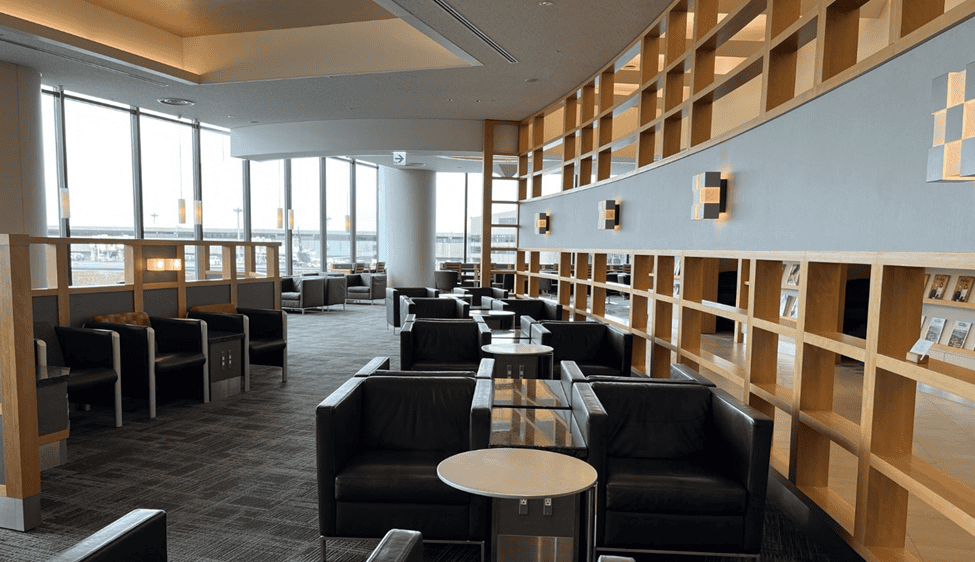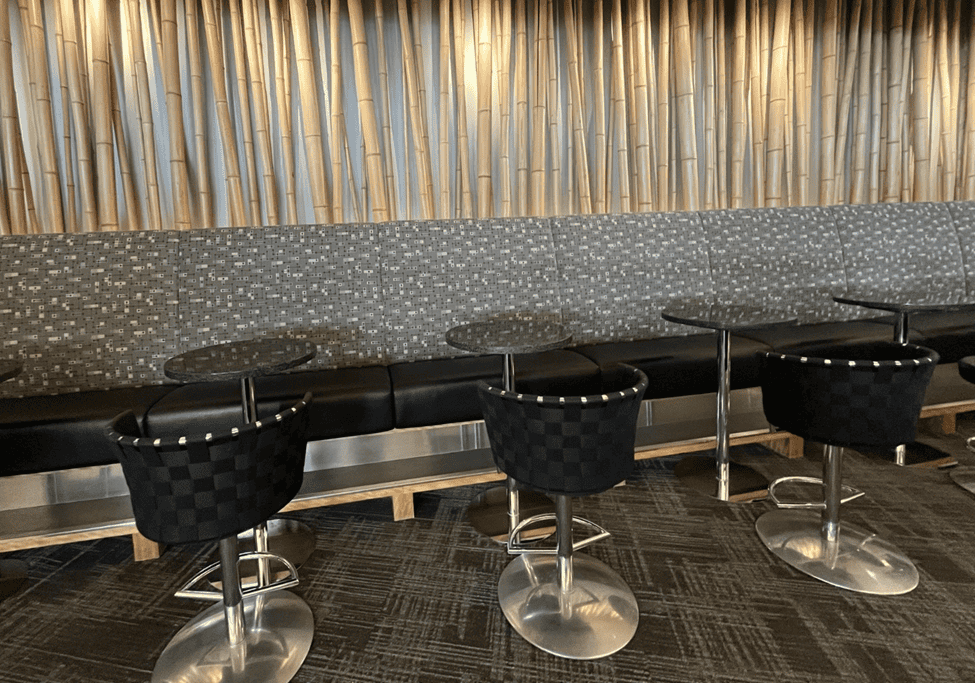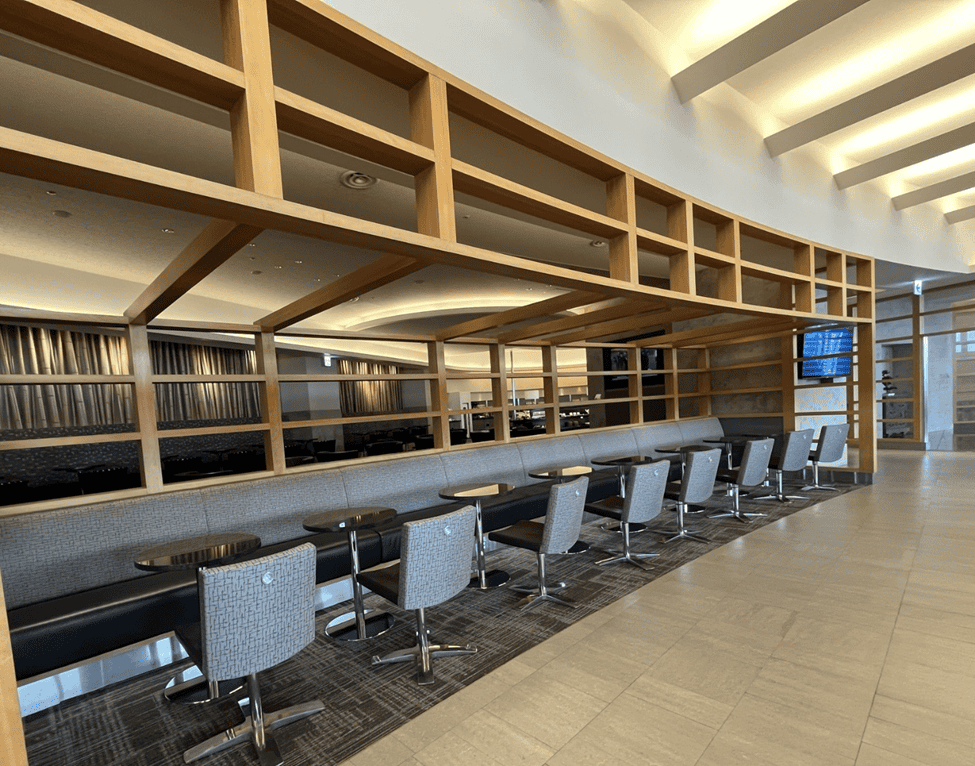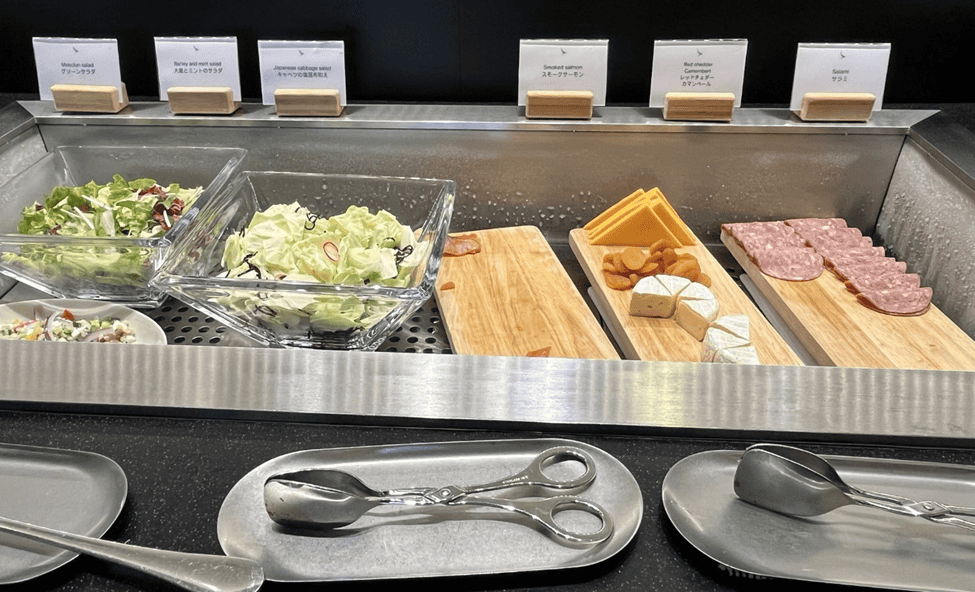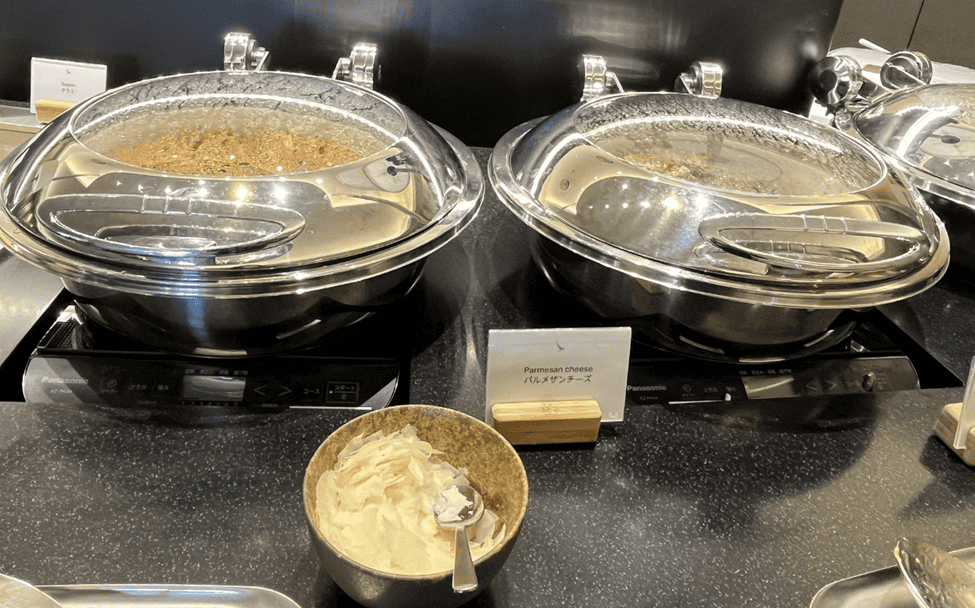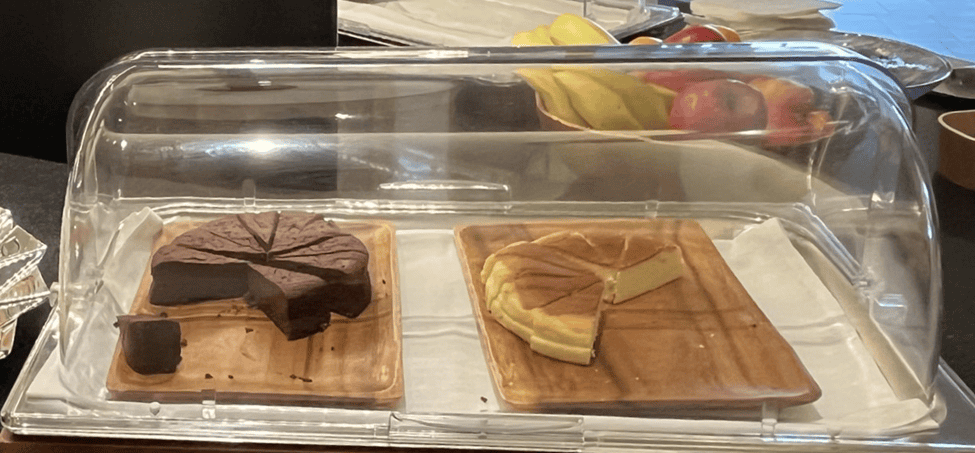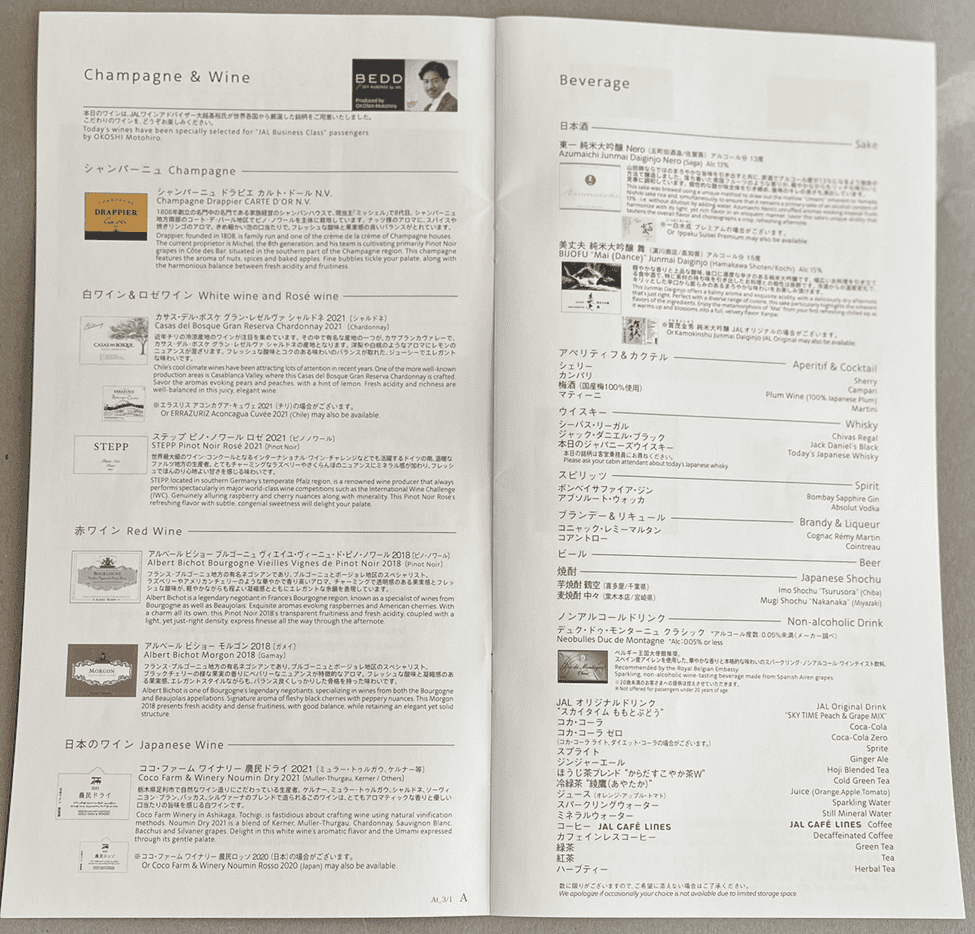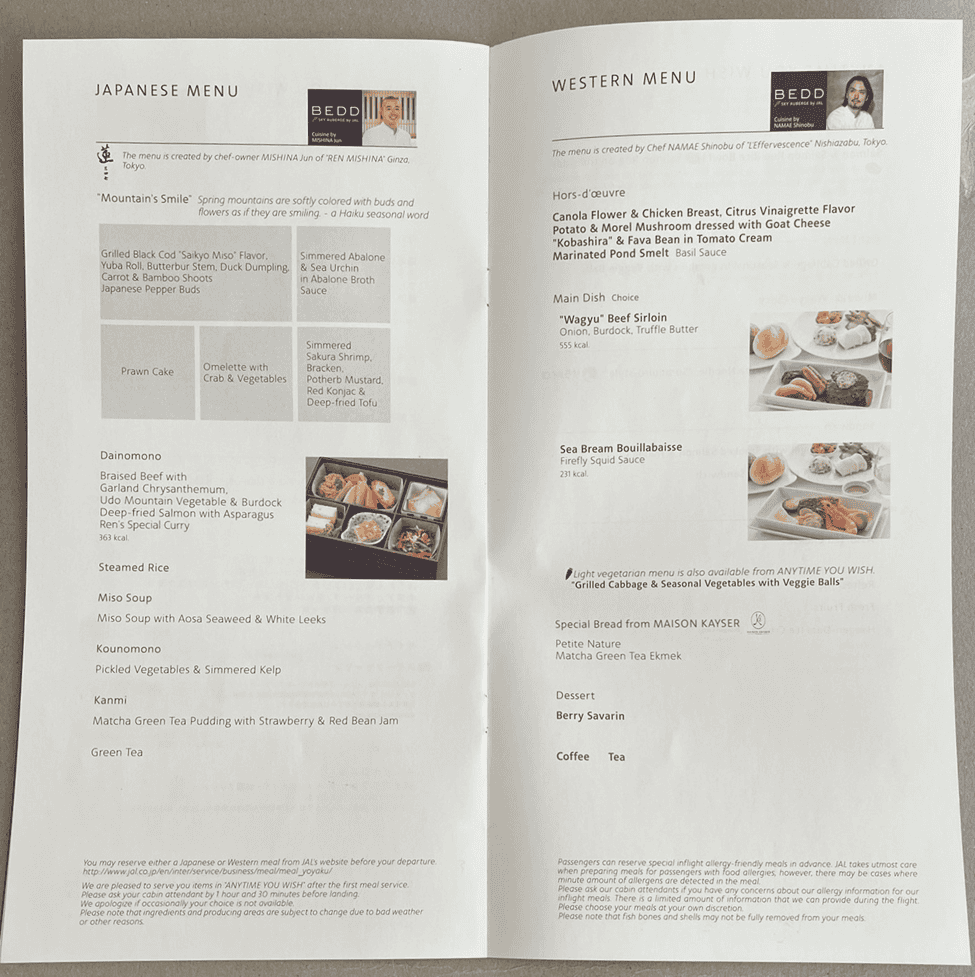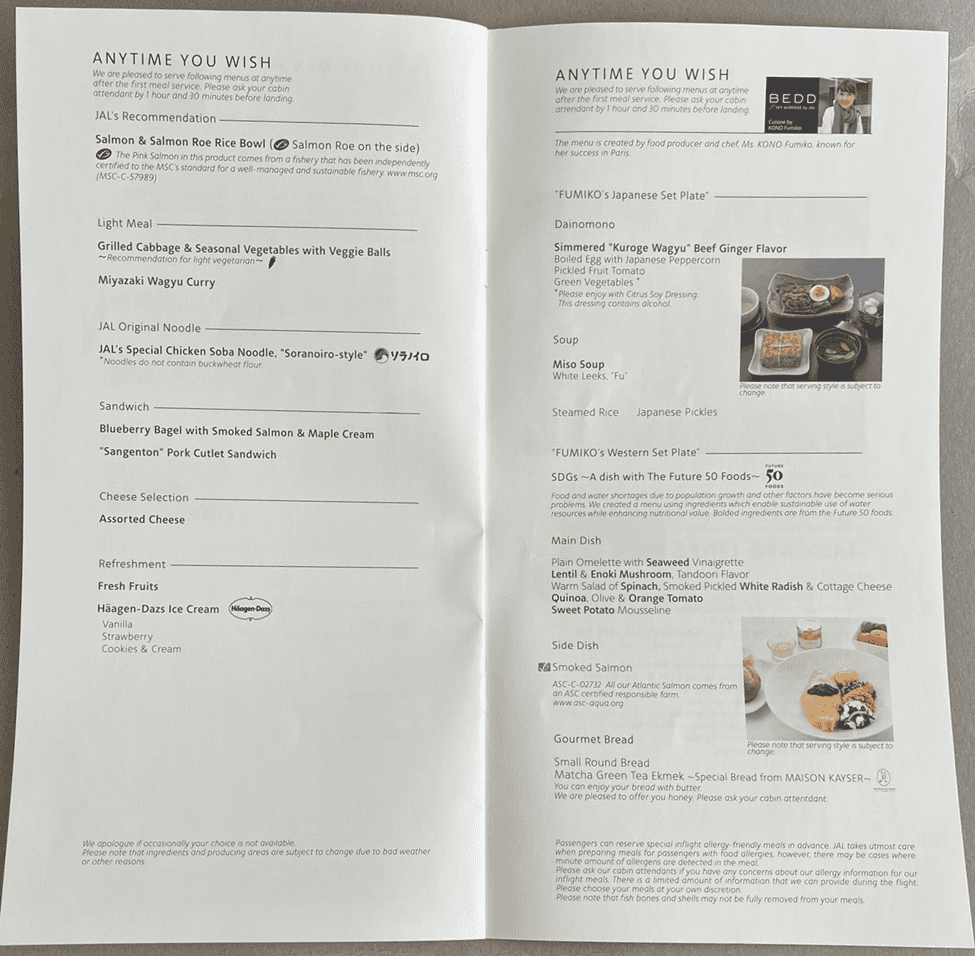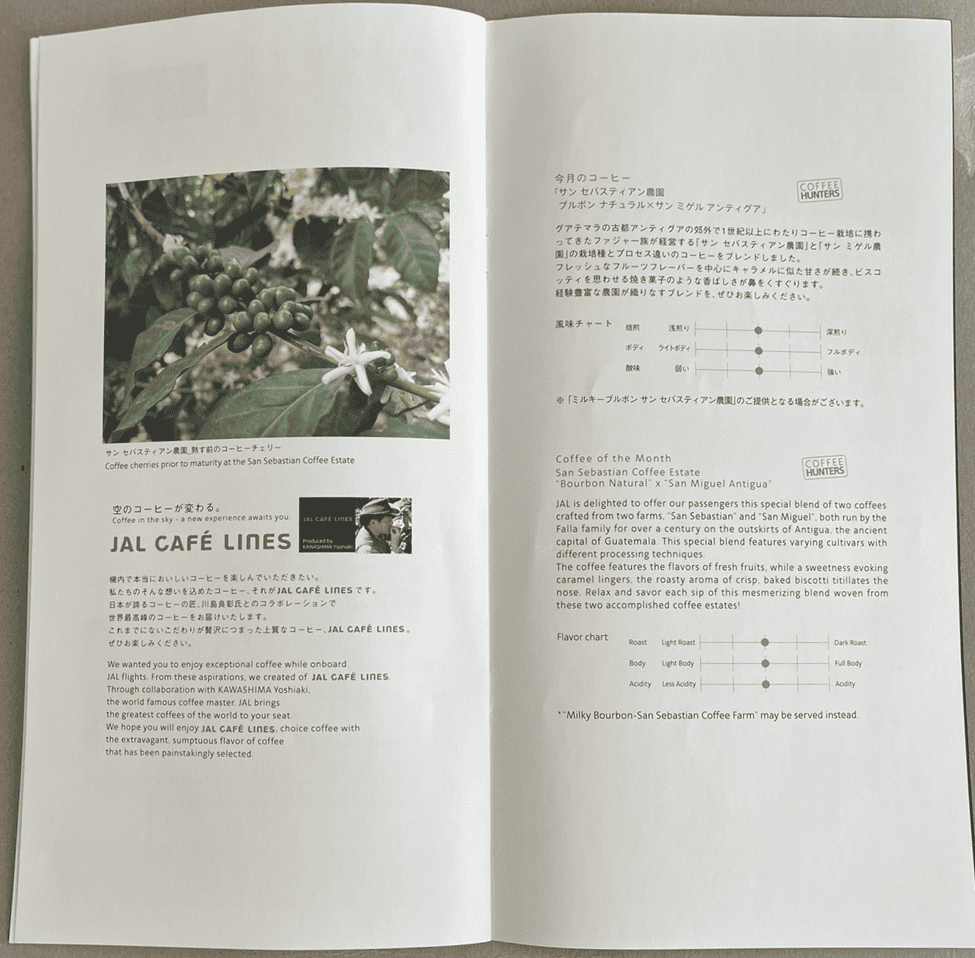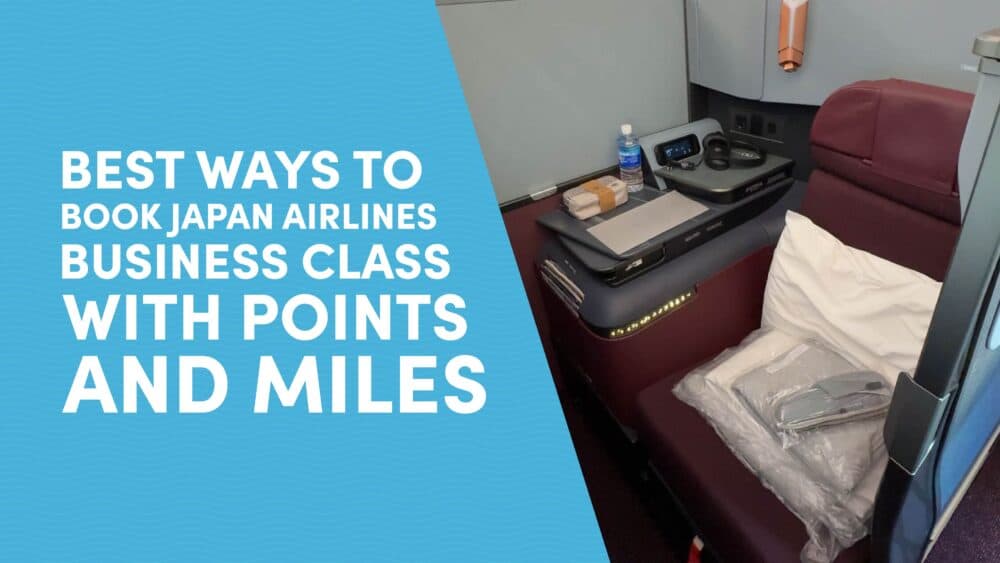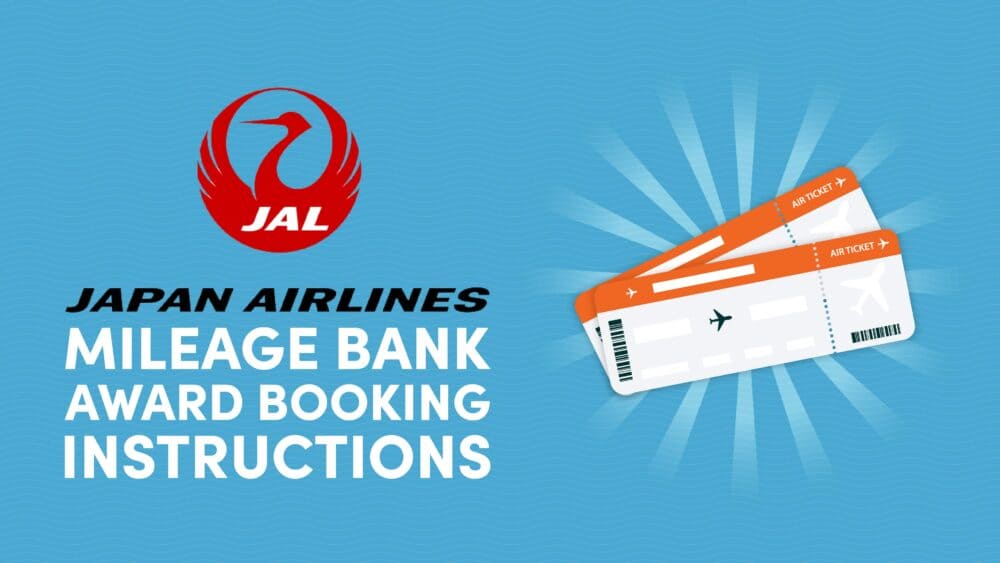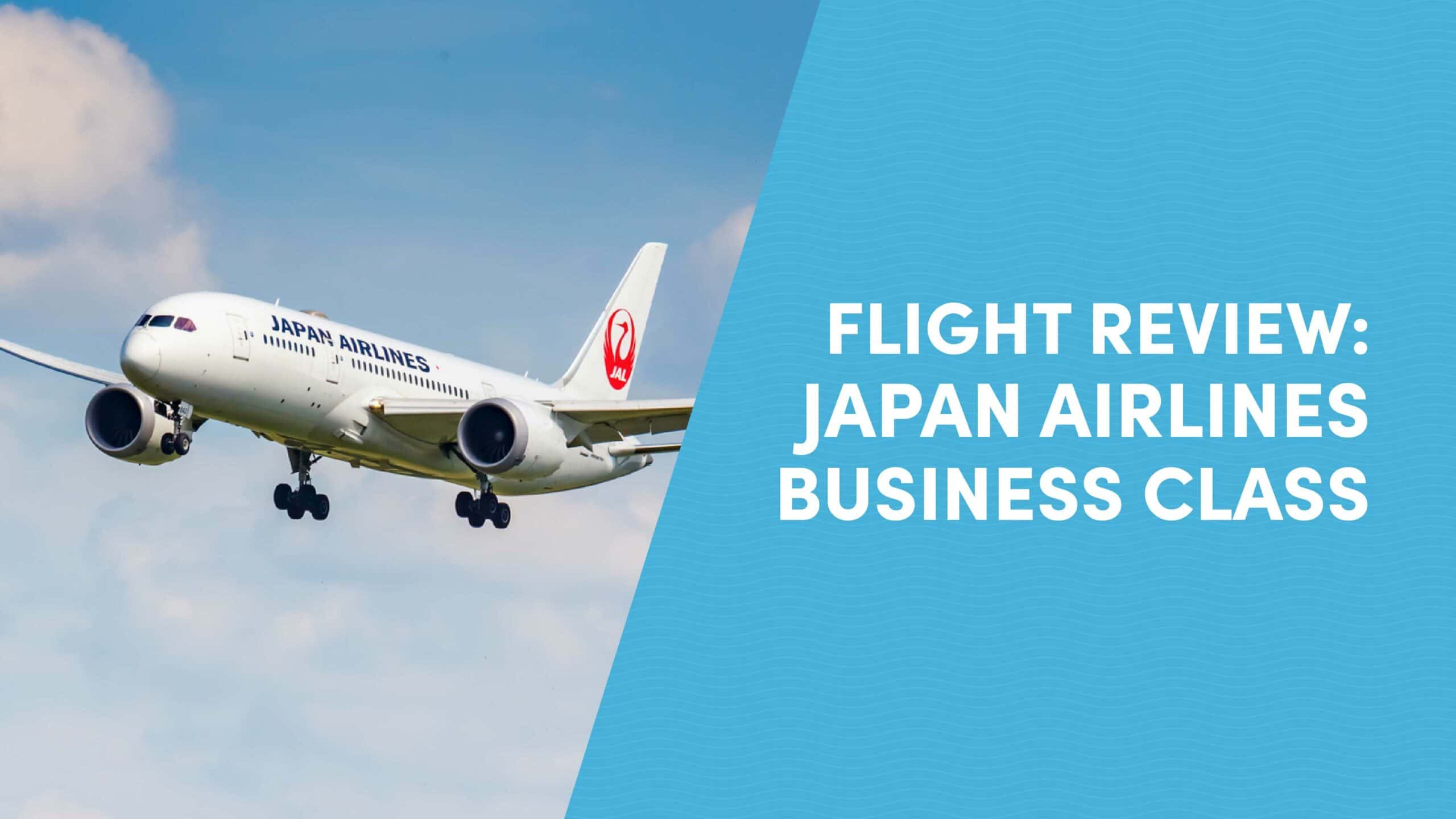
10xTravel is part of an affiliate sales network and receives compensation for sending traffic to partner sites, such as CreditCards.com. This site may earn compensation when a customer clicks on a link, when an application is approved, or when an account is opened. This compensation may impact how and where links appear on this site. This site does not include all financial companies or all available financial offers. Terms apply to American Express benefits and offers. Enrollment may be required for select American Express benefits and offers. Visit americanexpress.com to learn more. All values of Membership Rewards are assigned based on the assumption, experience and opinions of the 10xTravel team and represent an estimate and not an actual value of points. Estimated value is not a fixed value and may not be the typical value enjoyed by card members.
Note: Some of the offers mentioned below may have changed or may no longer be available. The content on this page is accurate as of the posting date; however, some of our partner offers may have expired. You can view current offers here.
This article is part of a larger Trip Report on Southeast Asia, where you can learn about flights, lounges and hotels within this route.
Citi is an advertising partner
In March 2023, I flew Japan Airlines in international business class between Tokyo (NRT) and San Diego (SAN) as part of a longer trip home to the United States from Southeast Asia.
Overview of Japan Airlines Boeing 787-800 Business Class
I flew from Hanoi, Vietnam to the United States on an American Airlines business-class award ticket that included four segments:
- Japan Airlines business class between Hanoi, Vietnam and Tokyo
- Japan Airlines business class between Tokyo and San Diego
- American Airlines business/first class between San Diego and Philadelphia
- American Airlines business/first class between Philadelphia and Tampa, Florida
I briefly discussed the first, third and fourth flights in my trip report introduction.
This review addresses the flight between Tokyo (NRT) and San Diego (SAN) in Japan Airlines business class.
Japan Airlines is a Oneworld member airline, and it operates international long-haul flights, as well as flights within Asia and domestic flights within Japan. Most international long-haul flights operate to and from Tokyo, which has two international airports, Tokyo-Narita (NRT) and Tokyo-Haneda (HND). Japan Airlines uses multiple types of planes for its international flights.
How I Booked a Japan Airlines 787-800 Business-Class Flight
This flight was part of a four-segment itinerary I booked through American Airlines’ AAdvantage program about 10.5 to 11 months in advance. The cost for the one-way ticket was 70,000 miles plus $62 in taxes and fees.
One situation I encountered in booking Japan Airlines flights through American AAdvantage was slow ticketing. I previously booked different Japan Airlines flights as an AAdvantage award, and it took about a week to move through processing to ticketed status. I contacted American Airlines while waiting and was told that this was normal for Japan Airlines awards, particularly when booking far in advance. With this ticket, I waited a few weeks to follow-up, and the American Airlines agent had to do something to push it through the system to ticketed status.
Japan is one of the most popular countries for international travel, and if you’re interested in traveling between Japan and the U.S., booking this Japan Airlines flight through the AAdvantage program would cost 60,000 miles per person one-way.
AAdvantage miles can be obtained through credit card welcome bonuses and spending on co-branded credit cards issued by Barclays or Citi, including:
- AAdvantage® Aviator® Red World Elite Mastercard®
- AAdvantage® Aviator® World Elite Business Mastercard®
- American Airlines AAdvantage® MileUp® Card
- Citi® / AAdvantage® Executive World Elite Mastercard®
- Citi® / AAdvantage® Platinum Select® World Elite Mastercard®
- Citi® / AAdvantage Business™ World Elite Mastercard®
You can also obtain AAdvantage miles by transferring points from Bilt Rewards or Marriott Bonvoy programs.
Other options are to book Japan Airlines flights through Japan Airlines’ Mileage Bank program and other partners’ programs. Which program is best for you depends on which type of points and miles you have and when you book, among other factors.
If you’re booking flights almost a year in advance, it’s important to understand that different airlines open booking at different times. While U.S. airlines typically allow booking beginning around 11 months in advance, many foreign programs allow booking almost a year in advance. If you don’t have Japan Airlines miles, booking through partners that open booking earlier increases the chance of finding business-class awards.
Other programs that can be used to book Japan Airlines award flights include:
- Japan Airlines Mileage Bank: The redemption rate is 50,000 miles per person one-way for business class between the U.S. and Japan. Award availability should be better through Mileage Bank than other programs, but Japan Airlines isn’t a transfer partner with most U.S. flexible currency programs, so this option won’t work unless you have Japan Airlines miles or can transfer Marriott Bonvoy points to Japan Airlines. It’s also not possible to redeem miles unless your Mileage Bank account has been open for at least 60 days.
- Cathay Pacific Asia Miles: Asia Miles allows booking 360 days in advance, which is the earliest among Japan Airlines’ Oneworld partners. Business-class awards are 75,000 miles per person one-way, and all major flexible currency programs except Chase Ultimate Rewards can be transferred to Cathay Pacific.
- Alaska Airlines Mileage Plan: Under Alaska Airlines’ distance-based partner award pricing implemented in March 2024, one-way business-class awards on this flight would start at 75,000 miles. Alaska opens booking 330 days in advance.
- British Airways Executive Club: British Airways opens booking 355 days in advance and allows transfers from multiple flexible currency programs, including Chase Ultimate Rewards and American Express Membership Rewards. The downside of booking through British Airways is that awards are more expensive. At the time of writing, booking requires 92,750 miles one-way, and British Airways also has higher fees compared to some of the other options discussed above.
Japan Airlines sometimes releases additional award space close to travel dates, so if you’re not planning far in advance, another good time to check for award availability is a few days or weeks before a trip.
At the time of writing, the lowest cash price for this Japan Airlines one-way business-class flight from Tokyo (NRT) to San Diego (SAN) was around $4,100, whether booking about a week in advance, almost a year in advance or between those times.
While major flexible currency programs have travel portals where you can use points instead of cash to book most flights, given current cash prices for the route, redeeming points through them often represents poor value compared to booking through airline loyalty programs. For example, a flight costing $4,000 would require between 200,000 points—for Chase Sapphire Reserve® cardholders booking select premium travel with a 2x Points Boost offer—and 400,000 points with programs and cards with a 1 cpp redemption rate.
Japan Airlines Check-In at Tokyo (NRT)
I checked in at Hanoi (HAN) before my first flight and received boarding passes for all segments. My luggage was checked through to my final destination, although I needed to claim and recheck it after entering the U.S.
Upon landing in Tokyo (NRT) after my first flight, I went to the international transfers area and passed through a security checkpoint. After this, I proceeded to the gate and lounge areas in terminal 2. This was a quick and easy transit experience.
Lounges at Tokyo (NRT)
I had a layover of just over 10 hours in Tokyo. I considered leaving the airport, but I decided to stay at the airport and visit some lounges. I wrote a separate review of the Japan Airlines lounges where I spent most of the day.
Consistent with the Oneworld lounge access policy, lounge access was based on Oneworld carrier tickets in business class and Oneworld status. Specifically, I had access to business-class lounges—the Japan Airlines Sakura Lounge and the Cathay Pacific Lounge—since I was flying Japan Airlines business class. I also was able to access the JAL First Class Lounge given my Oneworld Emerald (American Airlines Platinum Pro®) status.
After several hours in the Japan Airlines lounges, I went for a walk around the terminal and visited the Cathay Pacific Lounge, which is located in terminal 2 on level 2, near gate 71. During the early afternoon, the Cathay Pacific Lounge was nearly empty. As expected, this lounge was smaller than the Japan Airlines lounges, but it was large enough. I thought that the Cathay Pacific Lounge was more attractive and modern than the Japan Airlines business-class lounge.
While both Japan Airlines lounges primarily used an ordering system and had very little food available for self-service, the Cathay Pacific Lounge had a more traditional airport lounge buffet. The buffet wasn’t extensive for an international lounge, but that was understandable given that Cathay Pacific was operating a small percentage of their pre-pandemic flight schedule, and the lounge likely wasn’t getting a lot of visitors.
Food available on the buffet included salads, cheese, deli meats, breads, a few hot dishes, some whole fruit and some desserts. Some of the food items looked like they had been sitting out a while or hadn’t been replenished.
Snacks and beverages were available at other stations in the lounge.
I only ate some snack mix and a piece of chocolate cake from the buffet. I love chocolate, and the Japan Airlines lounges didn’t have chocolate desserts. The cake fulfilled my chocolate craving.
Boarding Japan Airlines at Tokyo (NRT)
Boarding for my flight was scheduled to begin at 4:45 p.m. for a 5:05 p.m. departure, but boarding was delayed for about 15 minutes.
Business-class boarding was organized with passengers boarding from a jet bridge. Boarding group 1 was top tier Japan Airlines elite members, and group 2 was business-class customers. I boarded as part of group 2.
Japan Airlines 787-800 Business-Class Cabin and Seats
Japan Airlines business class on the Boeing 787-800 plane used for my flight consists of 30 seats in five rows in a 2-2-2 configuration. The business-class cabin is divided into two sections with three rows of seats in the front section and two in the back section. Japan Airlines refers to these seats as Sky Suites, but they use the same terminology (sometimes numbered) to refer to other types of seats, so it’s important to check what type of seats are on a specific flight. People sometimes refer to the 787-800 seats by the generic name, Apex.
For the configuration on my flight, the seats in both side sections are staggered, as shown below. Unlike many aircraft, the window seat has a separate access aisle.
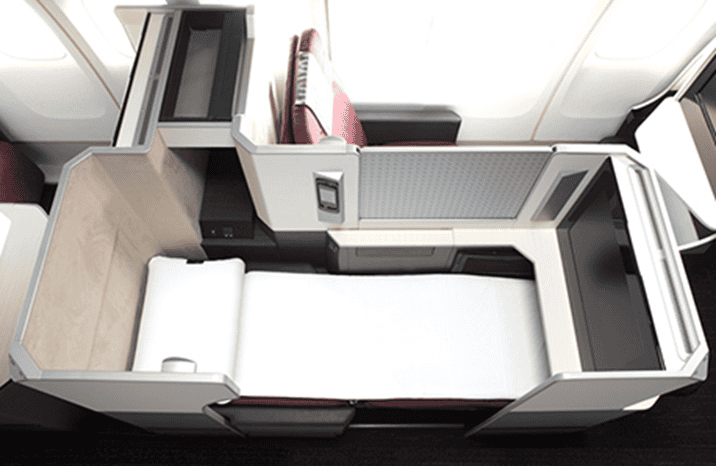
Sky Suites 787-8 window section staggered seats | Photo courtesy of Japan Airlines
Window seats are the best seats for solo travelers, since they are the most private and have a view.
The best seats for two people traveling together who want to communicate during the flight or for someone who needs to provide assistance to a travel companion are the middle section seats, as they are aligned with each other, rather than being staggered. Choosing a window seat and the aisle seat next to it also would work for talking to a companion.
The retractable dividers between seats covered the full height of the partition between adjacent seats, providing good privacy when desired.
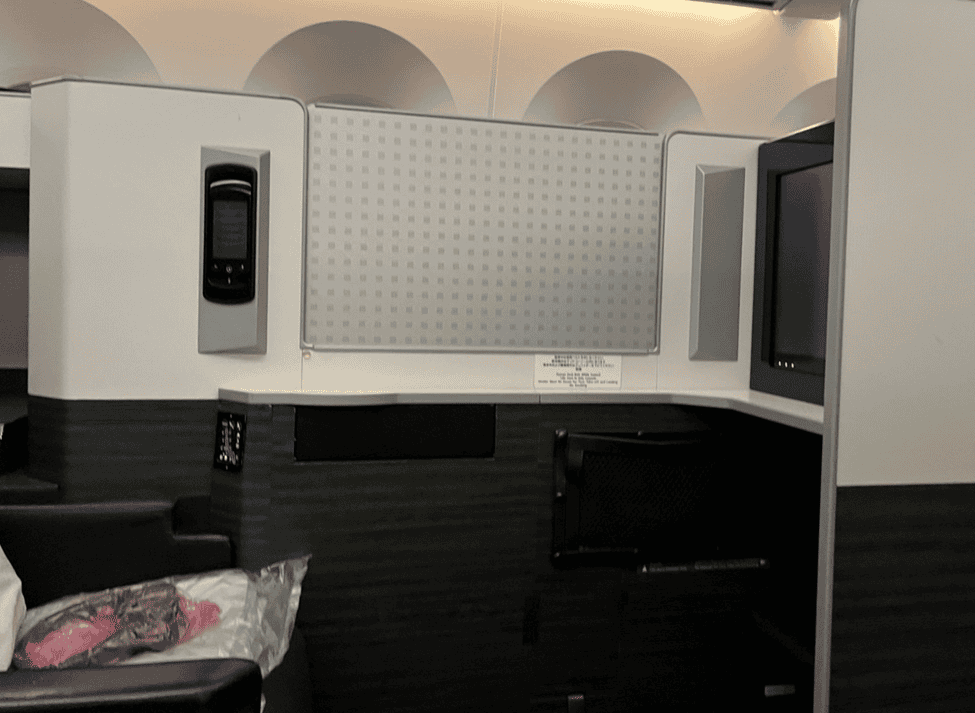
Japan Airlines seat divider with gray retractable section | Photo by Julie Neafach
I selected a seat in the center section in the second row. While I was initially disappointed that I couldn’t select a window seat, I thought my seat provided sufficient privacy. I had more privacy than usual since the seats next to and across the aisle from me weren’t occupied.
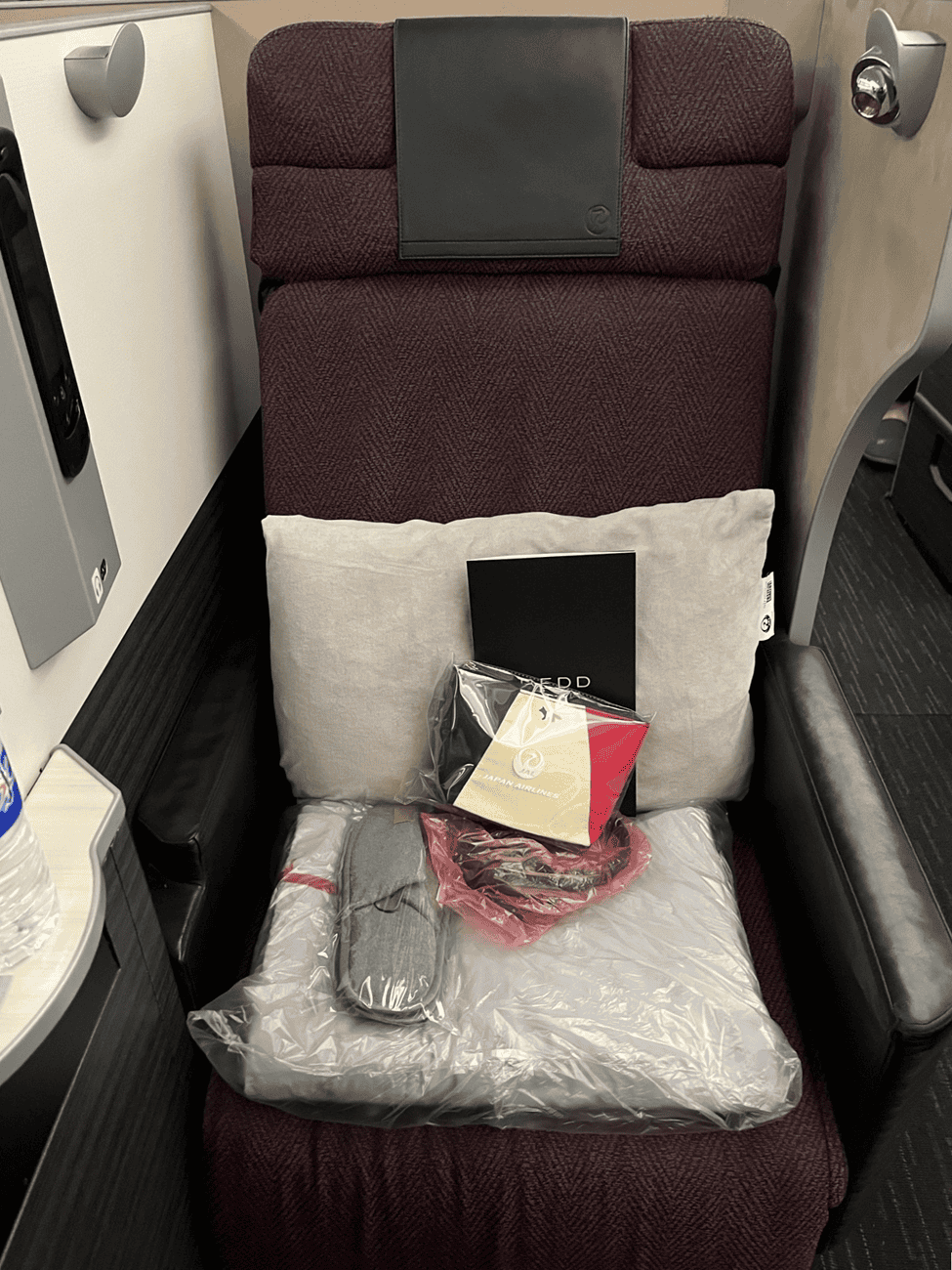
Japan Airlines center section business-class seat | Photo by Julie Neafach
Regarding the inability to select window seats, I read that window seats sometimes are reserved for Japan Airlines Mileage Bank elite members, but I’m not sure if that’s correct or if window seats had already been selected by others before I selected my seat.
Storage was a mix of good and bad on this plane. Overhead storage consisted of large, dedicated (numbered) bins for each business-class seat. Storage space near the seat was extremely limited other than the footwell area and the space under the footwell shelf, which can’t be used for storage during takeoff or landing.
Overall space and lighting were fine. Lighting was overhead. The size of the seat and footwell were good. Seatguru noted the seat width as 25.5 inches and seat/bed length as 74 inches.
The entertainment screen was large (noted as 23 inches), and entertainment controllers and plugs for headphones were located on the seat divider and side of the seat respectively.
The universal electrical outlet and USB port were located under a narrow built-in shelf in front of the entertainment screen and around the side of the seat. The plugs were located near the corner, above the footwell. Given the distance from the seat, these plugs were difficult to reach when sitting in the seat.
Seat controls were located on the side of the seat and were customizable with standard buttons to adjust the seat, control the lights and contact a flight attendant. It was easy to change the seat into bed mode.
The tray table pulled out from the side of the seat and was a single piece that didn’t fold. Japan Airlines general information about Sky Suites—which wasn’t specific to this particular aircraft—indicated that the table swivels, but I didn’t verify that functionality on the specific plane used for my flight.
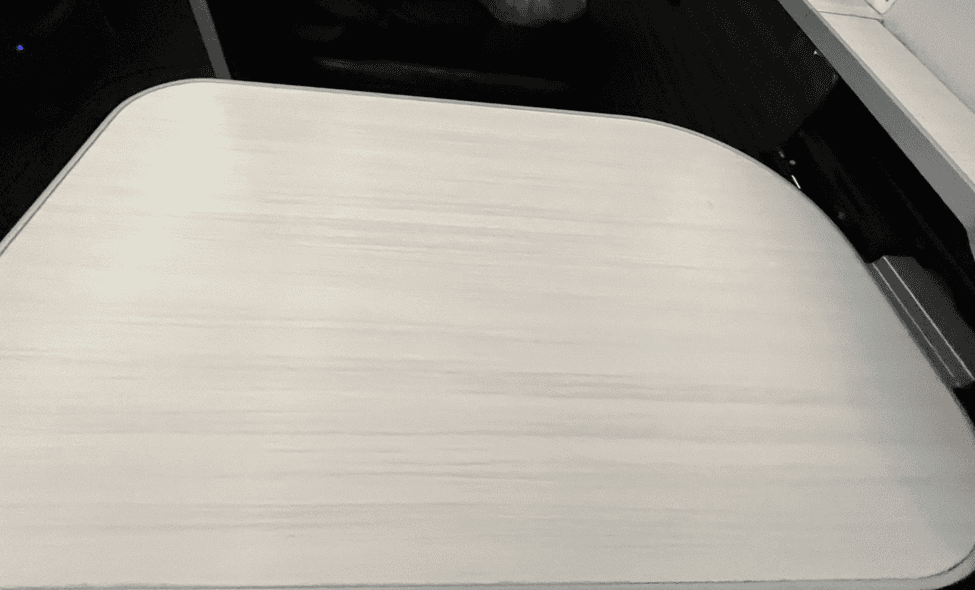
Japan Airlines business-class seat tray table | Photo by Julie Neafach
The footwell space was large and nearly the width of the seat. Since all seats faced straight ahead, the footwell also was straight ahead. The footwell provided enough space for side sleepers.
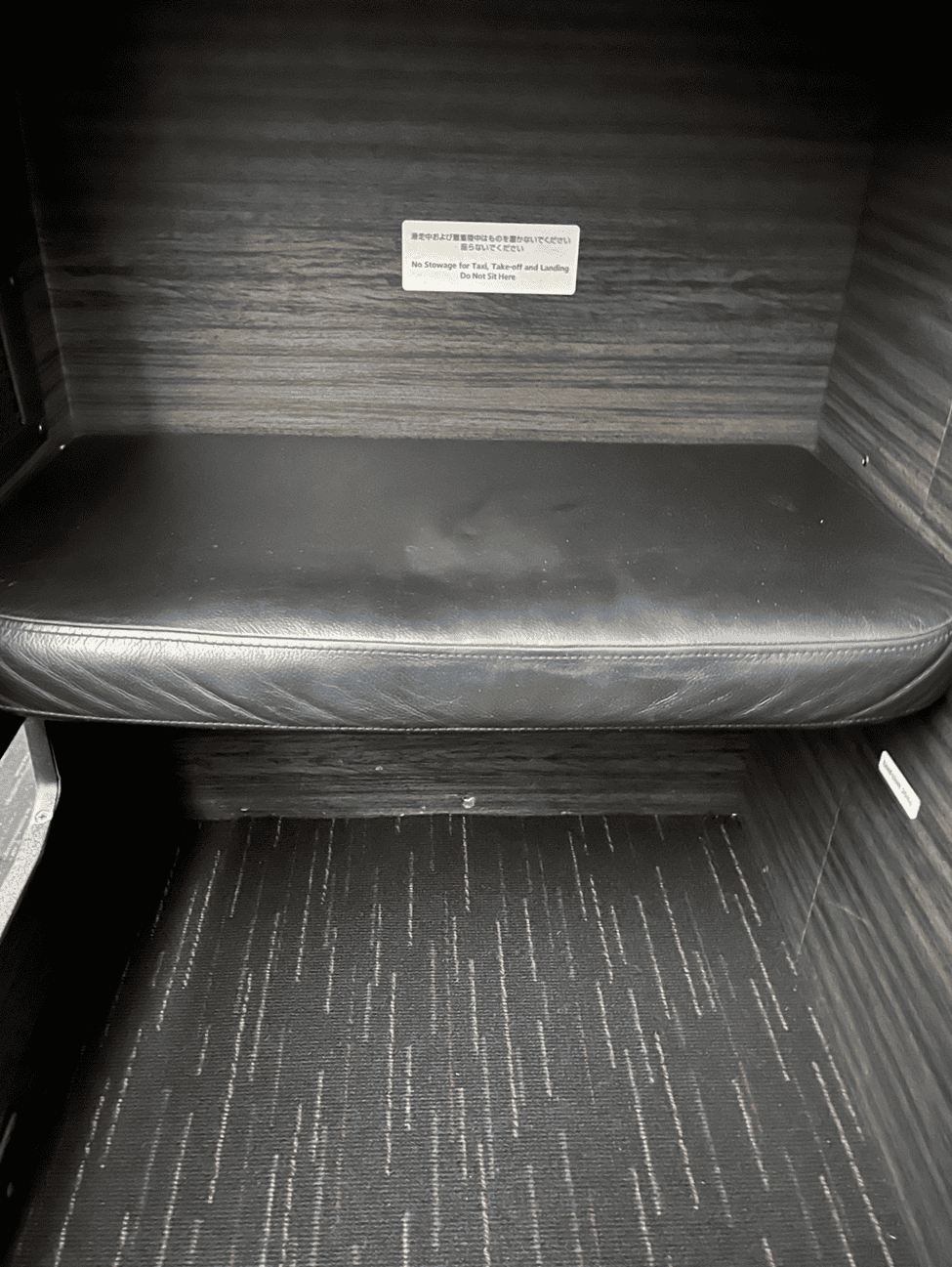
Japan Airlines business-class seat footwell and storage space | Photo by Julie Neafach
There were no individual air nozzles on this plane.
No snack area was set up on this flight.
Overall, seats on this plane had some pros and cons. Positive aspects included large footwells and entertainment screens. Negative seat features included lack of single seats, limited storage and awkward placement of electrical and USB plugs.
Japan Airlines 787-800 Business-Class Bathrooms
The plane had two bathrooms for business class; one at the front of the plane and one between the two business-class sections. I had to wait for a bathroom after dinner and before arrival.
The bathrooms were pretty nice but on the smaller side. They had Japanese toilets with rinsing functionality. Amenities included some large bottles of Harris Miller branded lotions and soap. There was also hand sanitizer available.
Japan Airlines 787-800 Amenities
At boarding, amenities—including a bottle of water, a clothes hanger, a blanket, a pillow, slippers, headphones and an amenity kit—were present at each seat.
Japan Airlines Business-Class Amenity Kit
The amenity kit bag and some contents were Maison Kitsuné branded. Amenity kit contents were limited and included an eye mask, ear plugs, a moisture mask and a dental kit containing a toothbrush and toothpaste.
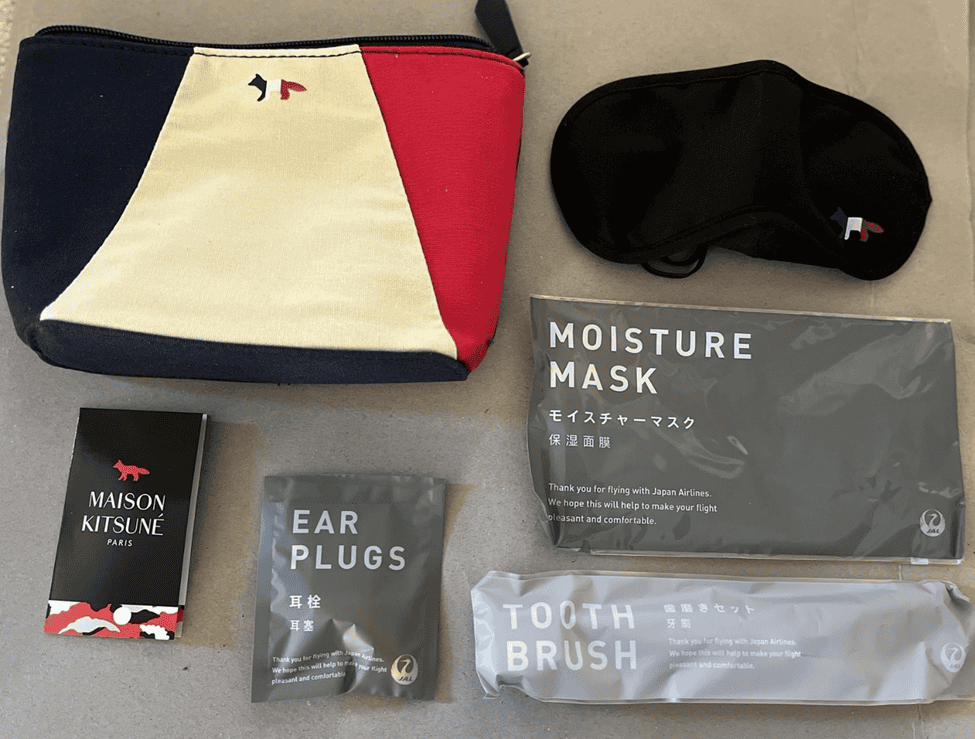
Japan Airlines business-class amenity kit | Photo by Julie Neafach
The overall quality and assortment of items seemed below average for international business-class amenity kits, but my understanding is that basic amenity kits are normal for Japan Airlines. My much shorter overnight Japan Airlines from Hanoi (HAN) to Tokyo (NRT) had a similar amenity kit with the differences being that the bag and contents on the first flight weren’t designer branded and the kit also had a shoe horn.
Japan Airlines Business-Class Entertainment
The headphones provided were labeled as “Japan Airlines” and were of average quality.
The entertainment system was somewhat difficult to use, since there were no touchscreen capabilities, and the handheld controller was tedious to use. In addition, entertainment options that I prefer—English language movies and television shows–were quite limited.
Japan Airlines Business-Class Bedding Amenities
One blanket, one pillow, slippers, a cardigan sweater and seat toppers were available on this flight. The blanket, pillow and slippers were at each seat when boarding. Flight attendants offered passengers cardigan sweaters. Unlike pajamas provided on other airlines that passengers can keep, the sweaters were for in-flight use only. The seat topper was in the overhead bin at the beginning of the flight.
Japan Airlines Business-Class Pre-Departure Amenities
Pre-departure beverages were offered and choices included: water, orange juice and champagne. Beverages were served in plastic cups, although they were a more upscale style.
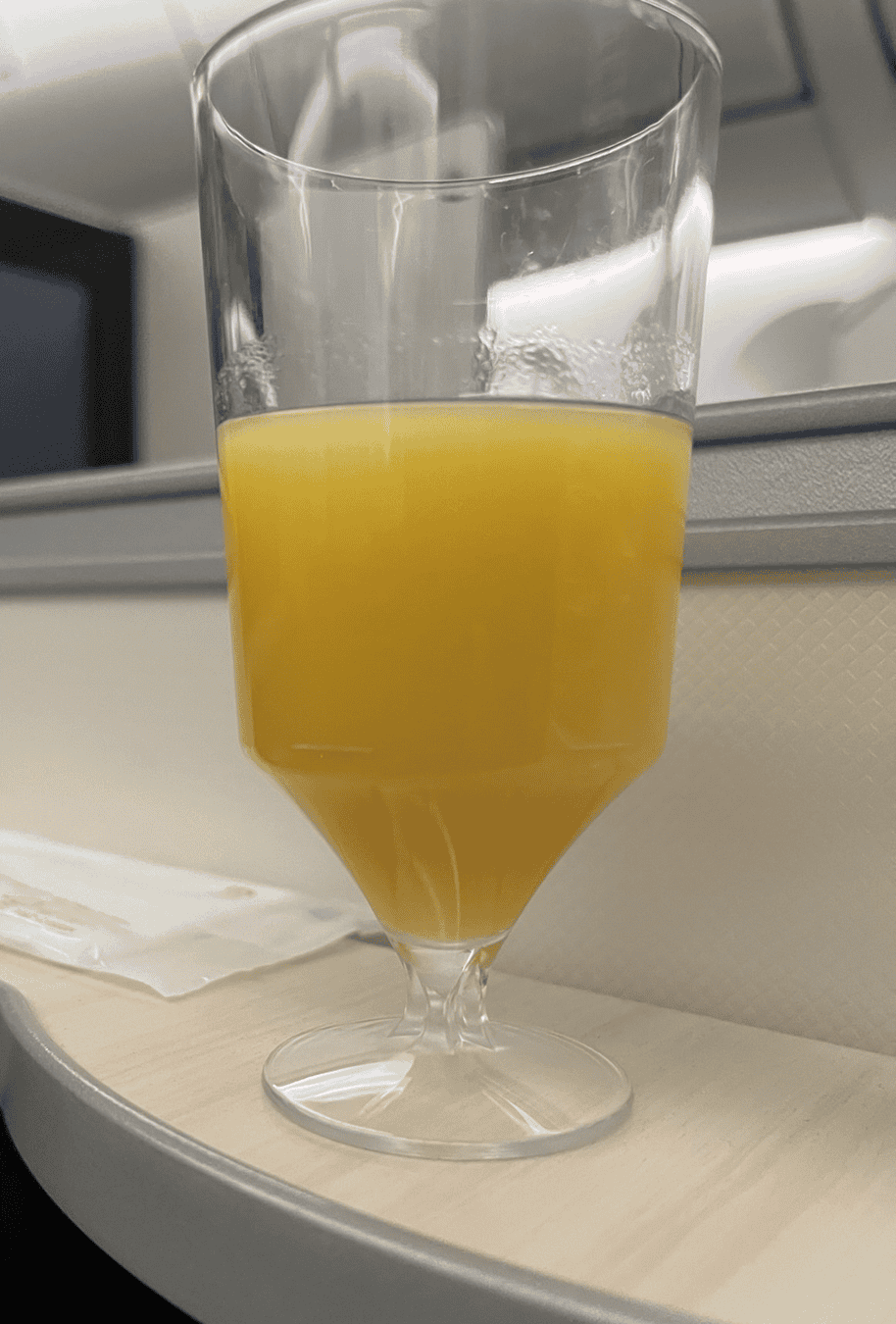
Pre-departure beverage | Photo by Julie Neafach
Japan Airlines 787-800 Wi-Fi
The plane was equipped with Wi-Fi. I wasn’t planning to use Wi-Fi on this flight, but when I tried to check the pricing, I got an error message indicating that the functionality was temporarily disabled. I didn’t ask a flight attendant about it or check later.
Japan Airlines Business-Class Menus
A detailed paper menu was available at each seat at boarding. The menu was in English and Japanese. It included options for the main meal service, anytime dining and beverages. Beverages included champagne, wine, sake, other spirits, beer and non-alcoholic drinks.
Japan Airlines Business-Class Takeoff from Tokyo (NRT)
Takeoff was behind schedule, since boarding started late. The departure was further delayed when some passengers did not board the flight, and Japan Airlines had to remove these passengers’ checked bags. The plane took off just before 6:00 p.m.
The front three rows of the business-class cabin were over 70% occupied. I didn’t see how full the flight was in the back section of business class or other cabins.
It was a little bumpy after takeoff, so the seatbelt sign stayed on for about 15 minutes
Japan Airlines Business-Class Dinner
The first meal service began shortly after takeoff. Given the flight departure time and food choices, I considered this meal to be dinner.
Once the initial turbulence subsided, the flight attendants offered a choice of beverages, and served these on a tray with a packaged moist towel and two ramekins with olives in one and mixed nuts in the other. I ordered a glass of Chilean chardonnay. They also took dinner orders at this time.
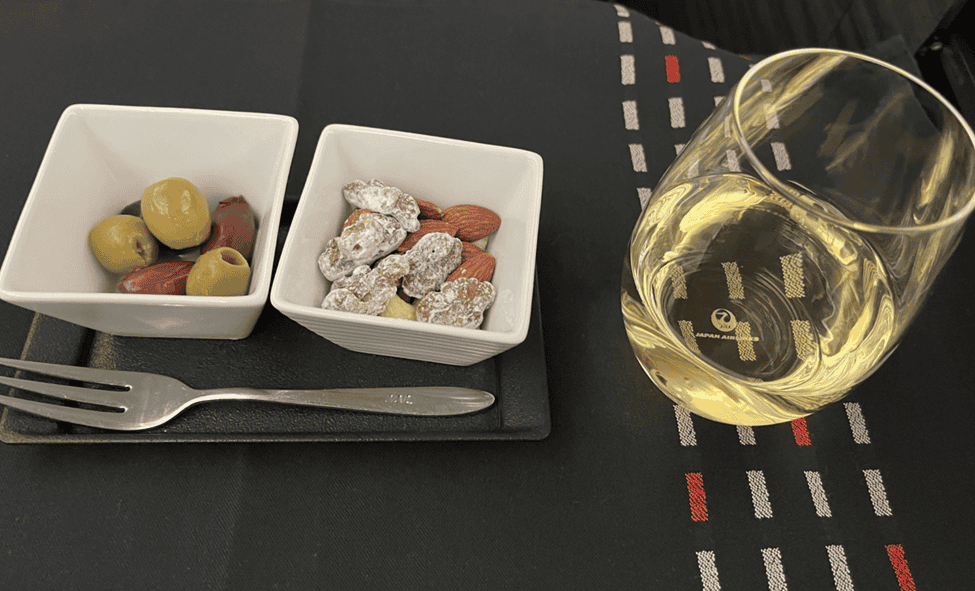
Olives, nuts and wine | Photo by Julie Neafach
For this meal and generally for fixed meal services, Japan Airlines offered a choice of a Japanese menu or a western menu. Passengers select either the Japanese or western option for all courses.
For dinner, I selected the Japanese menu. It was served in multiple courses. Since I’m not too knowledgeable about Japanese food besides sushi, I appreciated that the menu included detailed descriptions for each item in the bento box and each course.
The first course included five different bento boxes. I considered these to be appetizers and just tried a little bit of each item and ate more of my favorites, which were the cod with vegetables and Sakura shrimp.
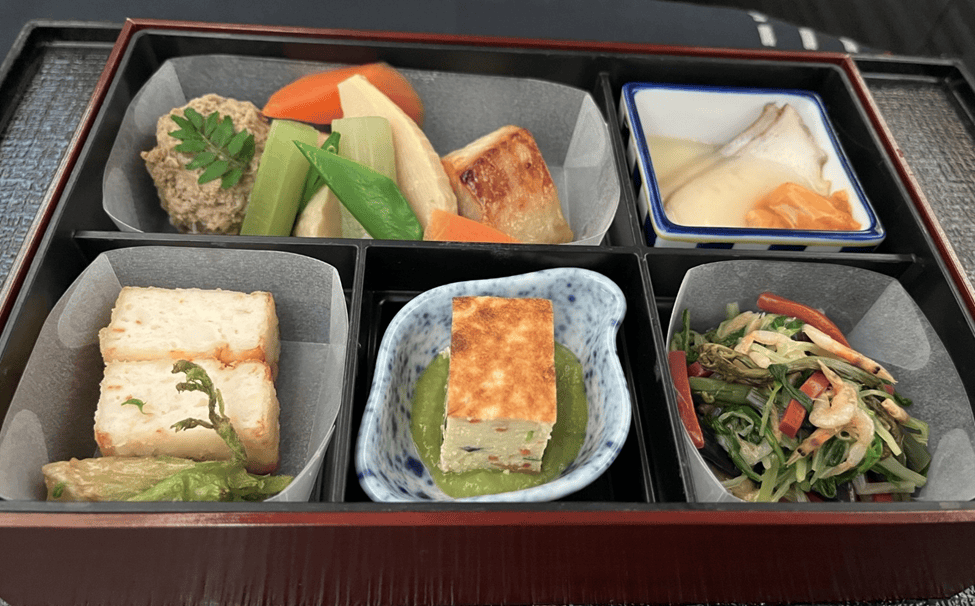
Japanese menu appetizers | Photo by Julie Neafach
The next course included rice, miso soup, salmon, asparagus, other vegetables, beef and curry. Although there was way too much food, I liked having the ability to try small portions of things I normally wouldn’t order.
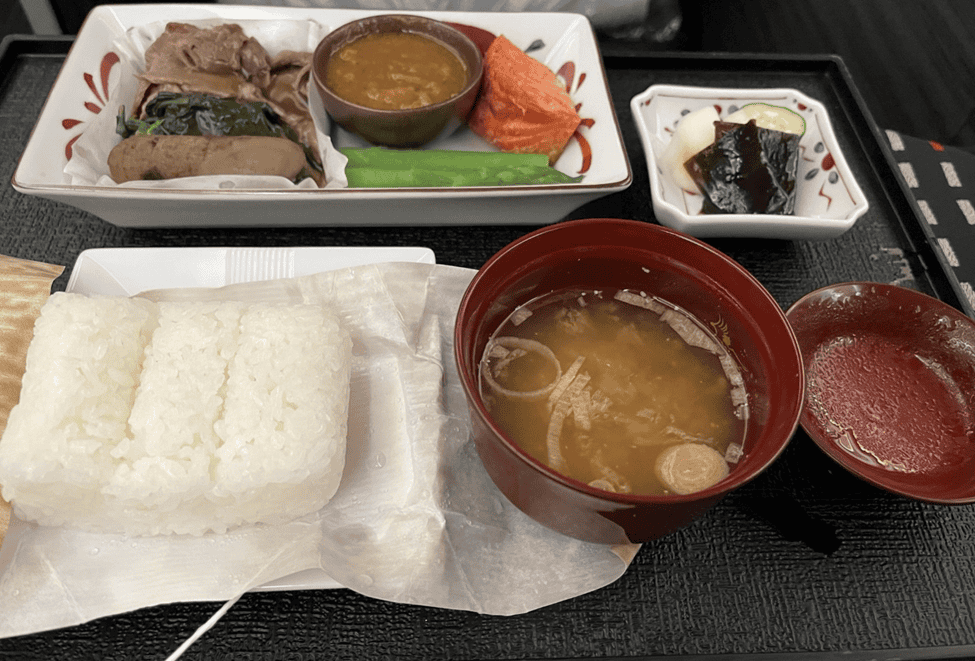
Japanese menu main course | Photo by Julie Neafach
The final course was matcha green tea pudding with jam and a cup of green tea. The matcha pudding was pretty good, but I was glad I had a chocolate dessert in the Cathay Pacific lounge.
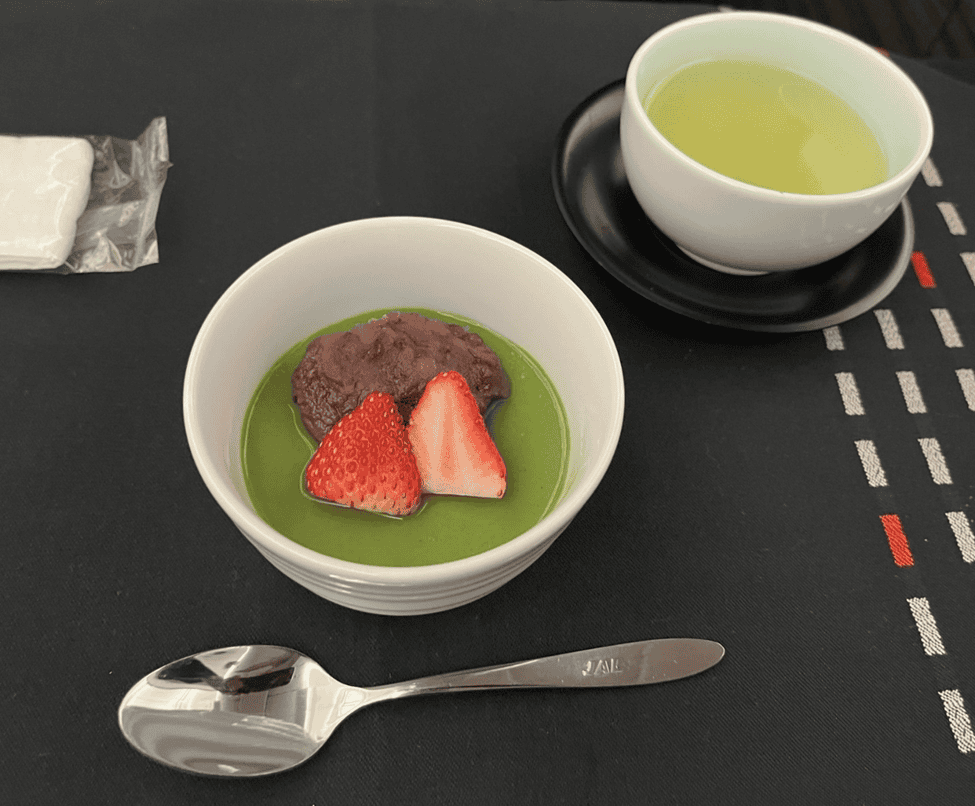
Japanese menu dessert and tea | Photo by Julie Neafach
The quality of food was good, and the amount of food served with the Japanese menu was substantial.
Cabin lights were dimmed after the end of the first meal service, about 2.5 hours after takeoff. I thought the pace of service was appropriate.
Japan Airlines Business-Class Anytime Dining and Breakfast
After the first meal service was complete, Japan Airlines switched to on-demand dining until 90 minutes before landing. The “Anytime You Wish” menu pictured above included some light meals that were more lunch, dinner or snack types of food as well as Japanese and Western set plates, intended as breakfast options.
Since the overnight flight was scheduled at under 10 hours, I tried to get some sleep after dinner and ordered breakfast about 1.5 to 2 hours before landing. I wasn’t hungry enough to want another large meal, so I ordered coffee, fruit, the smoked salmon side dish and bread. Since there was a sandwich item that was a blueberry bagel with smoked salmon, I asked for some cream cheese, but they didn’t have cream cheese. I improvised and made my smoked salmon sandwich with some soft packaged cheese the flight attendant provided.
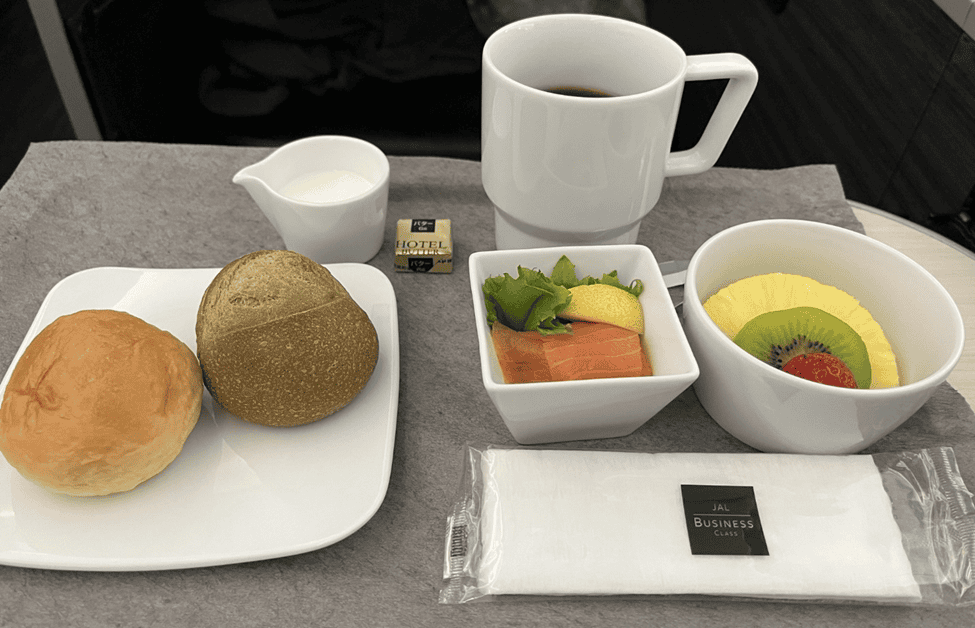
A la carte breakfast from the anytime menu | Photo by Julie Neafach
Similar to dinner service, I thought the quality and taste of my simple breakfast selections were good.
Japan Airlines Business-Class Bed
As noted above, a blanket and pillow were available at each seat when boarding, and seat toppers were stored in the overhead compartments. In comparison to the bedding on the much shorter Japan Airlines overnight flight from Hanoi to Tokyo, the pillows were similar, but the flight between Tokyo and San Diego had a more substantial quilted blanket and seat toppers.
I noticed what appeared to be a seat topper in the overhead bin when placing my bag there. Later in the flight, I asked a flight attendant if that was a seat topper, and she unfolded it and placed it on my seat.
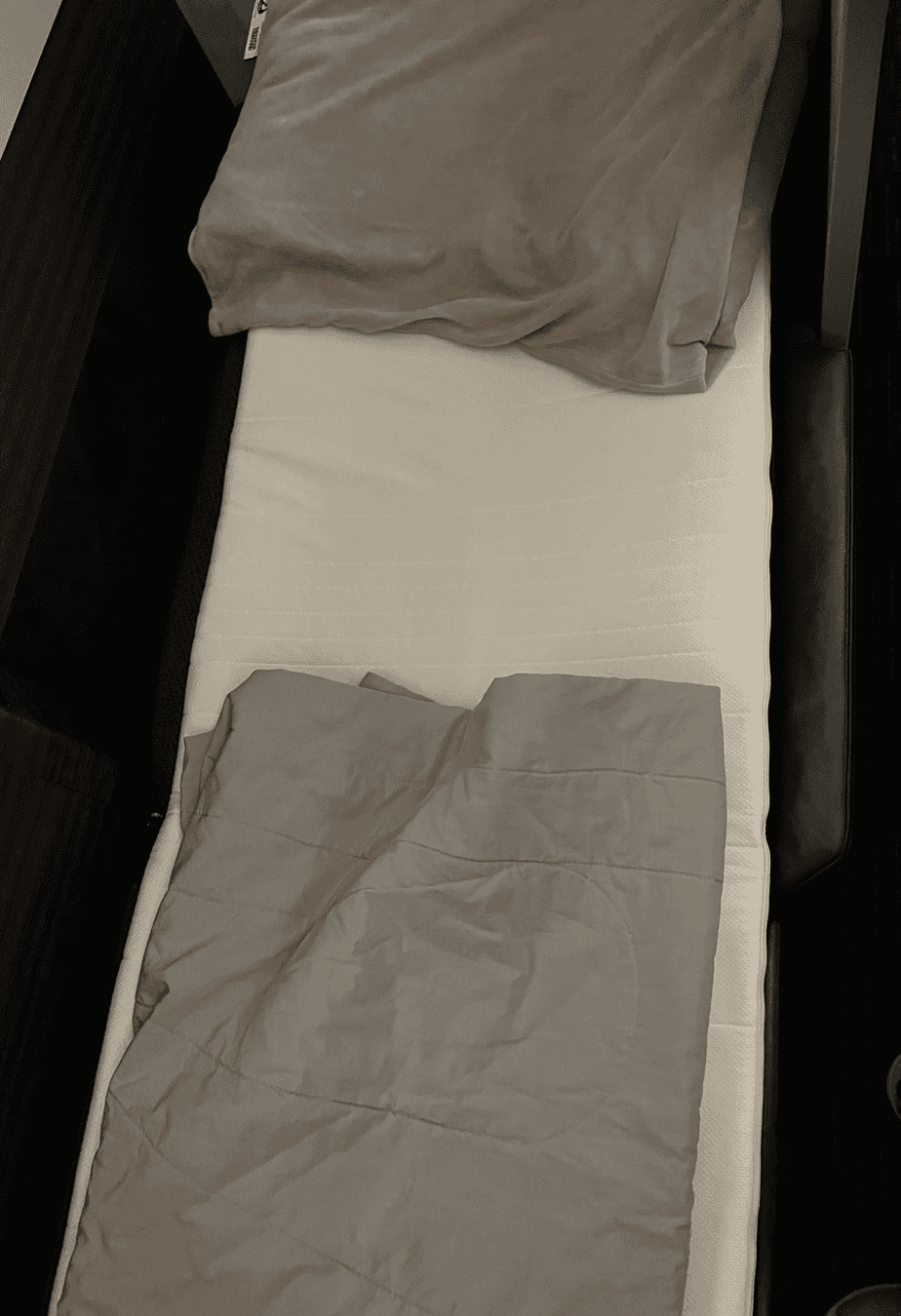
Seat in bed mode | Photo by Julie Neafach
The seat and bedding were good quality and comfortable, but I only got a few hours of light, interrupted sleep. I’m generally not very successful at sleeping on planes, and I developed a cold which made it more difficult to sleep on this flight. There was slightly less than six hours between when the first meal service was complete and when the cabin got busy with pre-arrival meal service.
Japan Airlines 787-800 Arrival
Arrival was about 25 minutes late, and we de-planed by jet bridge in San Diego.
For international arrivals in the U.S., passengers need to retrieve their checked luggage and go through customs and immigration. This was my first experience with an international arrival in San Diego, and it was a pretty easy process. Since I have Global Entry, I used one of the Global Entry kiosks and got my receipt. After retrieving my checked bag, I showed the receipt to the agent staffing the Global Entry line and spent less than a minute with the Customs and Border Protection agent. I re-checked my luggage for my U.S. domestic flight on American Airlines.
Facing a long layover before my overnight flight, I left the airport for a few hours. Even though it wasn’t the best weather for San Diego, some fresh air, a walk and a Starbucks drink loaded with caffeine and sugar were exactly what I needed after spending about 30 hours in airports and on planes.
When I returned to the airport, I visited the Aspire Lounge in terminal 2. This contract lounge serves as the Oneworld lounge for Japan Airlines business- and first-class passengers, and the lounge also participates in Priority Pass. It was crowded with nearly every seat filled and generally not great. Nevertheless, it served its purpose, and I was able to take a shower, have a snack and catch up on email.
Japan Airlines 787-800 Business-Class Family Friendliness
The cabin has an average layout for families traveling together. It’s good for two people who want to sit next to each other, specifically in the middle section. These seats would work for someone needing assistance or close monitoring during the flight. The cabin doesn’t have seats where more than two people can be close to each other during the flight.
Children’s selections were available on the in-flight entertainment system.
Overall Impression of Japan Airlines 787-800 Business Class
Based on my experience on this flight and the flight from Vietnam to Tokyo, my overall impression of Japan Airlines business class was largely positive. The best parts about traveling in Japan Airlines business class were the service and food. I mostly selected Japanese food, since a common opinion is that Japan Airlines’ Japanese options are better than the airline’s western options.
I thought the flight attendants on both flights offered excellent service at a time when Japan Airlines service was influenced by COVID-19 considerations. For example, flight attendants wore masks, and passengers were expected to wear masks when not eating or drinking. Packaged hand wipes were provided instead of flight attendants distributing and retrieving warm towels. Each meal course was served on a single tray, likely to reduce touchpoints.
I was traveling on my birthday, and flight attendants on both flights acknowledged it. I’ve flown on my birthday before, and this is the first time an airline has said or done anything. On the flight to San Diego, the flight attendants sang happy birthday and gave me a card and small bag with some packaged butter cookies.
I had mixed feelings about Japan Airlines’ business-class seats. I didn’t like the lack of single seats on Japan Airlines 787-800 planes and thought the design and storage space could be improved. Despite the configuration, privacy was better than I expected, and the seats were comfortable for sitting and sleeping.
Final Thoughts
These were my first two flights in Japan Airlines business class, so I wasn’t sure what to expect. I wouldn’t hesitate to fly Japan Airlines again if the routing worked for my travel plans, and I could book award tickets for a reasonable number of points.
This article is part of a larger Trip Report on Southeast Asia, where you can learn about flights, lounges and hotels within this route.
New to the world of points and miles? The Chase Sapphire Preferred® Card is the best card to start with.
With a bonus of 75,000 bonus points after you spend $5,000 on purchases in the first 3 months from account opening. , 5x points on travel booked through the Chase TravelSM Portal and 3x points on restaurants, streaming services, and online groceries (excluding Target, Walmart, and wholesale clubs), this card truly cannot be beat for getting started!
Editors Note: Opinions expressed here are author’s alone, not those of any bank, credit card issuer, hotel, airline, or other entity. This content has not been reviewed, approved or otherwise endorsed by any of the entities included within the post.



